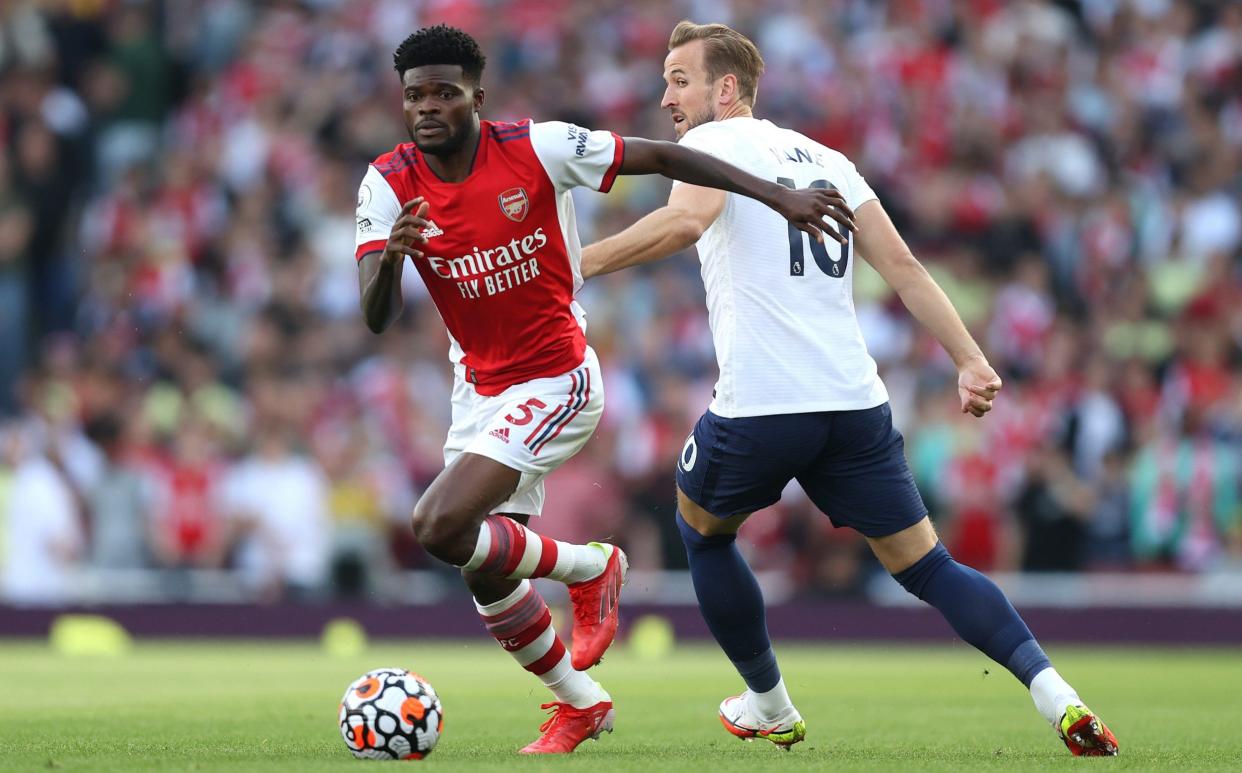Arsenal have been trying to replace Patrick Vieira for 15 years - Thomas Partey might just do it

It was on the night of Thomas Partey’s full debut for Arsenal, away to Rapid Vienna in the Europa League, when Martin Keown delivered the line that the club’s supporters had been waiting to hear. “He looks like Patrick Vieira to me,” said Keown, triggering an online frenzy and another wave of excitement over Arsenal’s new midfielder.
The hype was building in these early days of Partey’s Arsenal career, and it went into overdrive a few weeks later when Roy Keane made the same point. “I had my battles with Vieira and I think this kid has got a chance of matching what Patrick used to do,” said the former Manchester United captain.
Keown, Vieira’s old team-mate, and Keane, Vieira’s old nemesis, could hardly be better placed to draw such comparisons. Their words were significant, and they were duly seized upon by a group of supporters who had been waiting more than 15 years for a player who was capable of replacing the midfielder who was so fundamental to their success under Arsene Wenger.
That wait has been long and painful. Unfortunately for Arsenal, it is still not over. Partey has obvious class, and perhaps could one day become the “new Vieira”, but injuries have so far prevented him from showing it on a regular basis.
As Vieira prepares to make his return to north London with Crystal Palace on Monday night, his shadow therefore still hangs over the Arsenal midfield. Since he left the club in 2005, Arsenal have gone full circle in their attempts to create a new heart of the side, and in many ways the post-Vieira midfield journey is indicative of the wider story — and decline — of the club itself.
The change in style in the second half of Wenger’s reign, the financial difficulties brought on by the stadium move, the mismanagement of the late 2010s and now the attempts to rebuild under Mikel Arteta: all of it can be viewed through the prism of the midfield void that was created when Vieira departed for Juventus.
It started with Cesc Fabregas, who embodied Wenger’s shift in approach following the club’s move to the Emirates Stadium. A side built around the young Fabregas, all technical skill and vision, was a markedly different side to one built around the domineering Vieira, and Arsenal changed accordingly.
The likes of Tomas Rosicky and Samir Nasri helped Fabregas to alter the aesthetic of the team, while the more defensive-minded players (Mathieu Flamini, Denilson, Alex Song) never came close to reaching Vieira’s level.
The fact that a player like Denilson would become so instrumental to the Arsenal midfield, making 73 league appearances from 2008 to 2011, was indicative of a deeper problem: money. As the likes of Chelsea and Manchester City spent heavily, Arsenal could not keep up as they were restricted by the costs of moving to the Emirates.
In those days, Arsenal could neither sign top-class players nor retain the ones they had. Fabregas, Nasri, Song, Emmanuel Adebayor and Robin van Persie all left at the peak of their powers, to be replaced by those of a different calibre. The end result was a midfield that was strikingly far removed from the days of Vieira.
Opta’s statistical records only cover the final two seasons of Vieira’s Arsenal career, which include the unbeaten campaign of 2003/04. Such metrics cannot do justice to a player of his class, but they do provide an indication of what Arsenal have been missing.
🇫🇷 Patrick Vieira: the blueprint for the complete midfielder 😎@OfficialVieira | #UCL pic.twitter.com/7t2IfXKnlF
— UEFA Champions League (@ChampionsLeague) March 8, 2021
In his last two seasons in north London, Vieira made an average of six tackles and five interceptions per game. Of all the players who have tried to replace him since, none of them have ever averaged more than four tackles per game. Francis Coquelin was statistically the most combative, but he offered nothing like the attacking thrust provided by Vieira. Only Fabregas produced more assists, and only Abou Diaby made more dribbles.
It is not just that Arsenal have not had an all-rounder like Vieira since the Frenchman left — they have not had anyone who even comes close. Perhaps the most promising was Diaby, but his repeated injuries ensured his potential was never fulfilled.
The arrivals of Arteta (2011) and Santi Cazorla (2012) represented a doubling-down from Wenger, who pursued his possession-based game until the end of his reign.
By that point, the cash was flowing again in north London. This increased financial firepower brought a new chapter in the post-Vieira tale, as Arsenal spent heavily on the midfield. In only two and a half years, almost £80m was invested in Mohamed Elneny, Granit Xhaka, Matteo Guendouzi and Lucas Torreira.
The failures of Guendouzi and Torreira to fill the void are reflective of the chaos behind the scenes in the immediate post-Wenger period, when it seemed every new month brought a strategic or executive change. They spent money, yes, but they did so badly.
All of which brings us onto this latest stage of the journey. Now manager, Arteta has built Arsenal’s most muscular side in years. Partey embodies that shift, and is so often compared to Vieira because of his similarly rangy style. To be labeled the new Vieira is a heavy burden, though, and Partey has some way to go to fill the shoes of the man who might never be properly replaced.
“Patrick was Patrick,” said Arteta on Thursday. “There is not going to be another one like him.”


